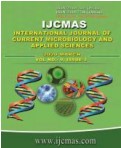


 National Academy of Agricultural Sciences (NAAS)
National Academy of Agricultural Sciences (NAAS)

|
PRINT ISSN : 2319-7692
Online ISSN : 2319-7706 Issues : 12 per year Publisher : Excellent Publishers Email : editorijcmas@gmail.com / submit@ijcmas.com Editor-in-chief: Dr.M.Prakash Index Copernicus ICV 2018: 95.39 NAAS RATING 2020: 5.38 |
The present experiment was commenced under the laboratory condition to studythe biological parameters of Diaphorina citri Kuwayama. The psyllid species, Diaphorina citri is potentially the most dangerous at the present time because it serves as vector for Citrus Huanlongbing which is the most serious disease of citrus in the world. Diaphorina citriis the only known vector of Huanglong-bing- a phloem-limited bacterial disease of international importance. Adults and nymphs suck sap from the phloem of tender shoots and buds, whilst adults also feed on the phloem of mature leaves. Severe infestations in orchards could lead to withering, distortion, and loss of immature leaves and irregular-shaped canopies. Citrus psylla are prevalent throughout the year but the high population coincides with the periods of new vegetative flushes on citrus plants during spring and summer. The population is sensitive to high rainfall and moisture condition and survives throughout the year without diapause, completing about 9-10 generations per year. The life cycle of Asian Citrus Psylla includes an egg stage and five nymphal instars. Study of citrus psyllid biology is necessary for decision making of appropriate management strategies and to reduce the economic damage.
 |
 |
 |
 |
 |